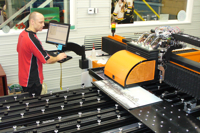
Features
Fabrication
Innovations
Glass Printing Comes of Age
Printing directly on glass is now simpler – and more profitable – than ever before.
 WEB EXCLUSIVE
WEB EXCLUSIVE
Glass printing comes of age
Glass is popular in many areas. It’s beautiful, versatile, and is the go-to material of choice where transparency is concerned. However, one disadvantage of glass is that it can be difficult to decorate.
 |
|
| Rob Halliwell operates the GlassJet machine installed at DSG Custom Glass in Langley, B.C. |
Feb. 25, 2010 – Glass is popular in many areas. It’s beautiful, versatile, and is the go-to material of choice where transparency is concerned. However, one disadvantage of glass is that it can be difficult to decorate.
That’s not to say that people don’t decorate glass. Of course they do. But there are many materials on which it’s considerably easier to print logos, words, or pictures. While there are a number of ways to put a design onto glass, they have certain disadvantages. Silk-screening, for example, means a firm must keep the screen on hand for years, on the off chance that the customer will want to repeat the order. In addition, a different size or shape means a new silk screen must be made, even if the design to be printed is exactly the same. This can be a huge hassle in certain areas.
In addition, glass printed by silk screen techniques will eventually suffer in appearance. A printed interlayer can be used in laminated glass, but laminated glass isn’t suitable for every application. In any case, most of the techniques for printing on glass are more complex, and therefore more expensive when compared to the cost of printing on other materials.
New applications
New technology that has recently become available is promising to change all of that. Actually, it isn’t exactly the technology that is new, but its application. In fact, the technology is very similar to that found in the standard inkjet printer found in offices and homes throughout Canada.
DIP Tech, a company based in Israel, manufactures a range of printers, specially designed to allow for digital printing directly onto glass. The full line consists of the GlassJet NOVO, the GlassJet 16PH, and the GlassJet24PH. The systems vary in size and price, but all three use ceramic inks as opposed to UV inks. Ceramic inks offer chemical durability, abrasion resistance, and extremely high UV resistance.
Colin Thom is the sales manager for DSG Custom Glass in Langley, B.C. The company is a division of Diamond Sea Glaze, the first company in Canada to install the GlassJet technology. They began using it in March of 2009.
“The machine was purchased primarily for our marine business,” says Thom. “There’s been a move in the marine world, especially in the luxury yacht and mega-yacht categories, towards custom and direct glazing. It’s been very useful in that area, but it can also print beautiful art. DSG Custom Glass was formed to take advantage of those capabilities, and introduce this new art to the architecture and interior design world.”
Digital benefits
Matthew Tangeman of Custom Glass Machinery has experience with the DIP Tech machines, having sold them to DSG and three fabricators in the United States. He’s also quick to point out the benefits of digital printing.
“With screen printing, if you need a replacement, and the screen has been lost or damaged, then you’ll have to have a screen made just to print that one piece,” says Tangeman. “On the other hand, if you have this digitally stored, you can call up the image file that was used originally, as well as the colour information. It’s much more efficient than either storing screens or making new screens for a single use. Using the DIP Tech GlassJet machines, you can produce anywhere from 15 to 60 square metres per hour, depending on the complexity of the image, the number of colours, and the image set-up. In addition, the intricacies of printed laminates getting stretched or misaligned due to operator error and UV color fading effecting the replaceability factor in façade projects are avoided with the GlassJet printing process.”
Digital printing allows for custom work in smaller batches than would have ever been thought possible. How about a single piece, for example a customized shower door? It sounds crazy if you’re used to tradition glass printing methods, but digital printing allows a fabricator to offer this to customers at a much lower price. Since all printing is digital, all the operator needs is a suitable digital image, such as a JPG or TIFF file.
General Glass International (GGI) has recently announced digital glass printing service under the name with “Alice”. Alice helps GGI conceptually market their new technology that allows custom, multi-colored designs to be printed on glass quickly and cost-effectively. GGI has already shown that the technology is useful for large projects as well as small ones.
The company has been working with architectural firm HOK New York on the Harlem Hospital project. The final printed image is actually three murals totaling 20 metres by 50 metres. It uses 439 individually printed glass panels.
 |
|
| Digital glass printing can be used for a variety of projects, both big and small. GGI worked closely with HOK New York to produce the murals which adorn Harlem Hospital. It is made up of 439 indivually printed glass panels, covering a total of 1000 square metres. |
Multitude of applications
The machines can be used to digitally print on many types of glass, including decorative and specialty glass, in a multitude of applications. Just a few of the places the technology can be used include curtain walls, table tops, building façades, office partitions, backsplashes, public art in lobbies and foyers, entrance door systems, shower enclosures in homes, nameplates on desks, signage and donor boards.
According to GGI, the company is currently working with the architectural, hospitality, design, glazing contracting and public art communities to incorporate the use of printed customized imagery in traditional and non-traditional spaces.
Although digital printing on glass has yet to achieve widespread use, Matthew Tangeman believes it is only a matter of time.
“Once the Harlem Hospital project is commissioned, and architects billings pick back up, I know my phone will be ringing. Obviously, there is some hesitation to jump in at first due to the unknowns about how to market the GlassJet capability,” says Tangeman. “My install base, here, and others globally, have all been amazed at the quote requests that start to come in once you have this capability and market it. Fabricators need to have faith in their own organization’s ability to market the capability. If they feel hesitant marketing to architects and designers instead of quoting glazing contractors as many do now, fabricators can establish an agent network that is experienced at marketing during the design stage of projects. That is thee largest objection prospective GlassJet owners have to implementing the technology.”
For more information on digital glass printers, please visit www.dip-tech.com .
Print this page
Leave a Reply